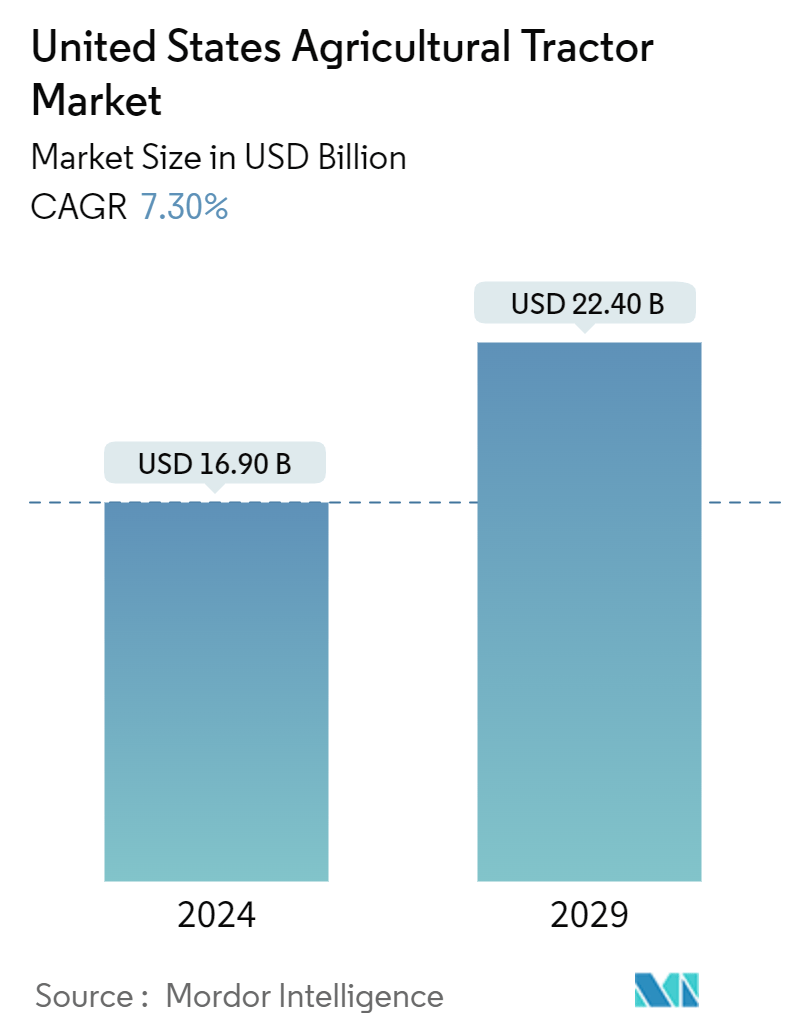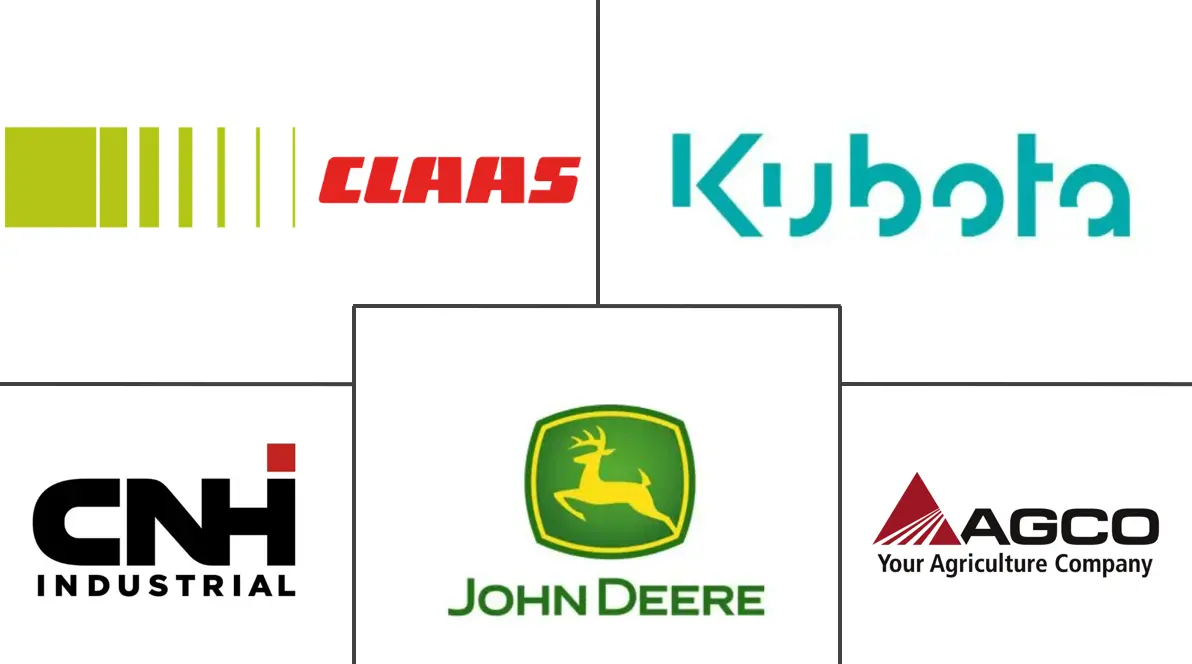Market Size of United States Agricultural Tractor Industry

| Study Period | 2019 - 2029 |
| Base Year For Estimation | 2023 |
| Market Size (2024) | USD 16.90 Billion |
| Market Size (2029) | USD 22.40 Billion |
| CAGR (2024 - 2029) | 7.30 % |
| Market Concentration | High |
Major Players
*Disclaimer: Major Players sorted in no particular order |
United States Agricultural Tractor Market Analysis
The United States Agricultural Tractor Market size is estimated at USD 16.90 billion in 2024, and is expected to reach USD 22.40 billion by 2029, at a CAGR of 7.30% during the forecast period (2024-2029).
- Driven by a vast agricultural sector and continuous investments in mechanized farming, the United States boasts one of the world's largest and most mature tractor markets. Steady growth in the U.S. tractor market is attributed to the rising mechanization in farming.
- Key drivers include a growing food demand spurred by population growth, technological innovations, and governmental backing for modern farming. Such dynamics have bolstered tractor sales nationwide. For example, sales of 4WD tractors in the United States saw a 9.4% uptick in May 2024 compared to May 2023, according to the Association of Equipment Manufacturers (AEM).
- The country's market caters to a diverse range of tractors, from compact models for smaller farms and landscaping to powerful machines designed for expansive commercial agriculture. Modern tractors in the United States are increasingly incorporating precision agriculture technologies, such as GPS, autonomous driving, telematics, and data analytics. These innovations empower farmers to boost yields, optimize fuel consumption, and cut labor costs.
- Additionally, there's a rising trend towards electric tractors and eco-friendly machinery, as firms aim to curb carbon emissions and adhere to stringent environmental standards. The momentum is also building for driverless and semi-autonomous tractors, with industry leaders like John Deere making significant investments in automation to enhance efficiency and trim labor expenses. The demand for sustainable farming and a decreased dependence on fossil fuels is likely to elevate the prominence of electric and hybrid tractors.
- In summary, while the United States tractor market thrives on technological advancements and the modernization of agricultural practices, it must navigate challenges like cost constraints and labor shortages in the future.
United States Agricultural Tractor Industry Segmentation
A tractor is a farm vehicle used to pull farm machinery and provide the energy needed for the machinery to work. For this report, tractors used in agricultural operations, especially four-wheeled tractors, have been considered. The United States agricultural tractor machinery market is segmented by horsepower into below 40 HP, 40-100 HP, and above 100 HP, and tractor type into utility tractors, row crop tractors, garden & orchard type tractors, and other tractor types. The report offers the market size and forecasts for volume (units) and value (USD) for all the above segments.
| Horse Power | |
| Below 40 HP | |
| 40-100 HP | |
| Above 100 HP |
| Tractor Type | |
| Utility Tractors | |
| Row Crop Tractors | |
| Graden & Orchard Type Tractors | |
| Other Tractor Types |
United States Agricultural Tractor Market Size Summary
The United States agricultural tractor market is poised for steady growth, driven by the mechanization of farming, which is crucial for enhancing productivity and supporting sales and exports. The shorter replacement cycles in the U.S. further stimulate demand for new tractors. Timely subsidies have enabled even small-scale farmers to invest in agricultural equipment, contributing to market expansion. The upward trend in agricultural employment and wages has also encouraged farmers to adopt tractors, boosting market growth. Innovations in tractor technology, such as fully electric and driver-optional models, are being supported by government programs to enhance efficiency and reduce reliance on diesel fuels.
The demand for row-crop tractors is increasing due to the scarcity of farm laborers and the need for mechanization in agriculture. These tractors are essential for various agricultural tasks and are designed to minimize crop damage. The market is expected to grow as the acreage of crops expands. The U.S. agricultural tractor market is highly consolidated, with major players focusing on new product launches, partnerships, and acquisitions to maintain their market share. Investments in research and development, along with the introduction of advanced tractor models, are key strategies for future growth. Companies like John Deere and Kubota are expanding their product lines and facilities to meet the evolving needs of North American customers, further driving market development.
United States Agricultural Tractor Market Size - Table of Contents
-
1. MARKET DYNAMICS
-
1.1 Market Overview
-
1.2 Market Drivers
-
1.2.1 Technological advancements drive Market Growth
-
1.2.2 Shortage of Labor In the Agriculture Sector
-
1.2.3 Government Support to Enhance Farm Mechanization
-
-
1.3 Market Restraints
-
1.3.1 High Initial Investments and Maintenance Cost of Farm Machinery
-
1.3.2 High Percentage of Small-Sized Farms Holdings
-
-
1.4 Porter's Five Forces Analysis
-
1.4.1 Threat of New Entrants
-
1.4.2 Bargaining Power of Buyers/Consumers
-
1.4.3 Bargaining Power of Suppliers
-
1.4.4 Threat of Substitute Products
-
1.4.5 Intensity of Competitive Rivalry
-
-
-
2. MARKET SEGMENTATION
-
2.1 Horse Power
-
2.1.1 Below 40 HP
-
2.1.2 40-100 HP
-
2.1.3 Above 100 HP
-
-
2.2 Tractor Type
-
2.2.1 Utility Tractors
-
2.2.2 Row Crop Tractors
-
2.2.3 Graden & Orchard Type Tractors
-
2.2.4 Other Tractor Types
-
-
United States Agricultural Tractor Market Size FAQs
How big is the United States Agricultural Tractor Market?
The United States Agricultural Tractor Market size is expected to reach USD 16.90 billion in 2024 and grow at a CAGR of 7.30% to reach USD 22.40 billion by 2029.
What is the current United States Agricultural Tractor Market size?
In 2024, the United States Agricultural Tractor Market size is expected to reach USD 16.90 billion.

